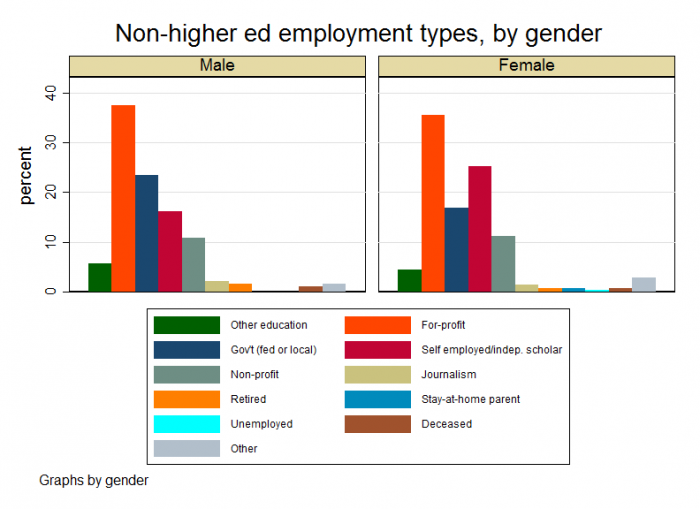We have data on both employment and gender for about 79% of our total sample. We know (from last time) that men in our sample are more likely to be employed in higher education, but approximately a quarter of our sample grads are employed outside of higher education. Are there employment trends by gender in these fields? We look to our data to find out.
The plot below clearly illustrates the dominant employment categories we identified in a previous post: the majority of grads working outside of higher education are employed in the for-profit, non-profit, and government sectors, or are self-employed/independent scholars. The distribution of employment categories looks relatively balanced by gender with the notable exception of higher self-employment among women and higher government employment in men. Our “self-employed/independent scholar” category contains a wide range of distinct occupations, but there is a particularly high density of women (compared to men) in writing/editing/publishing and counselling jobs.

We’ll begin to break down our composite employment categories in the coming weeks – these data will provide an even clearer picture of life post-grad.
We have data on both employment and gender for about 79% of our total sample. We know (from last time) that men in our sample are more likely to be employed in higher education, but approximately a quarter of our sample grads are employed outside of higher education. Are there employment trends by gender in these fields? We look to our data to find out.
The plot below clearly illustrates the dominant employment categories we identified in a previous post: the majority of grads working outside of higher education are employed in the for-profit, non-profit, and government sectors, or are self-employed/independent scholars. The distribution of employment categories looks relatively balanced by gender with the notable exception of higher self-employment among women and higher government employment in men. Our “self-employed/independent scholar” category contains a wide range of distinct occupations, but there is a particularly high density of women (compared to men) in writing/editing/publishing and counselling jobs.

We’ll begin to break down our composite employment categories in the coming weeks – these data will provide an even clearer picture of life post-grad.
Discussion